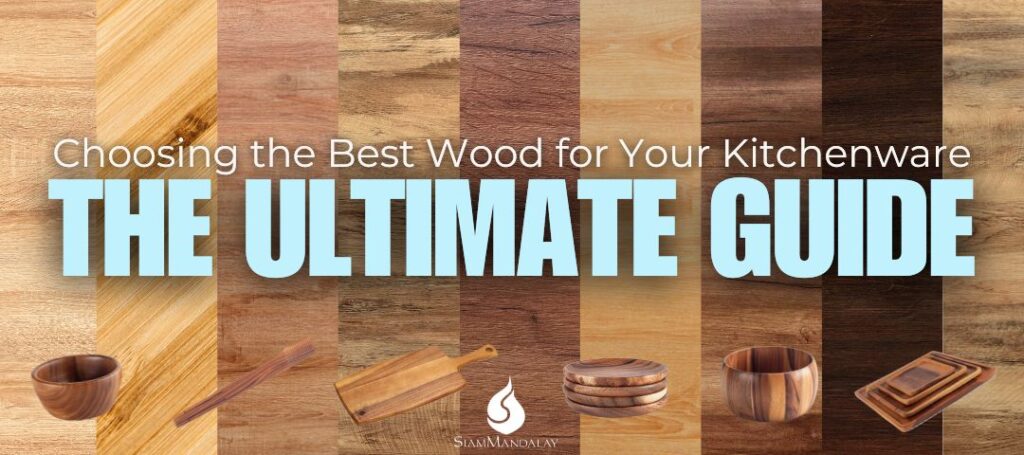
Choosing the right equipment for your kitchen is an important part of making any home. Ensuring you have all the correct equipment, made from the right materials can be difficult with so many different options saturating the market, especially when it comes to wood. Kitchenware can be made from so many different species of tree, that is becomes hard to cut through the noise and really figure out which woods work the best, and for what purposes. What makes a certain type of wood better or worse for use in the kitchen depends on a few different factors and properties of the wood.
Things to consider when picking out your wood kitchenware:
Hardwood vs. Softwood
One of the more impactful distinguishing factors among types of wood that dictates whether it works well for kitchenware is whether it’s a hardwood or a softwood. Contrary to popular belief, the terms hardwood and softwood do not refer to a wood’s resistance to scratches or indentations, but instead the kind of tree that it comes from. Hardwood comes from deciduous trees, which are trees that lose and regrow their leaves in a cycle each year. Whereas softwood trees are coniferous, maintaining leaves all year round. Within these two categories you can find several different woods with varying properties, but by and large, hardwoods do tend to be denser, heavier, and more durable than softwood.
It is also worth noting the density of the wood, which to some degree is influenced by whether it is a hardwood or softwood. Just because some wood is a hardwood does not mean that it is dense and hard enough for kitchen applications. Some woods’ surfaces are too soft to make good kitchenware, and some woods can even be too hard. For example, a wood like black ironwood that is too hard should not be used for cutting boards because they have a propensity to dull sharp knives. Whereas a softer surfaced wood provides more longevity to your blades, there are tradeoffs in other departments which make them less effective as cutting boards. Softwoods like pine and spruce should not be used for wooden spoons either, it is imperative to consider the kind of kitchenware item and its uses when deciding which wood is the best for your situation. Things like the kind of utensils you will use against it, what kind of heat exposure it faces, or how much liquid it will encounter all require different features from your wood.
Porosity
It is essential to consider all of the qualities and properties of the wood in order to make a decision about which is the best for your kitchenware needs, simply being a hardwood does not necessarily make it good for kitchenware. Another aspect of wood that plays a significant role in its functionality within the kitchen is how porous the wood is.
Hardwood trees are typically far more porous than softwood, which means it is easier for liquids, moisture, and even bacteria to become embedded deep in the wood. For these reasons, choosing a wood that is less porous is important when deciding on the material for your kitchenware. When moisture and liquid become embedded deep into the wood it can lead to mold, ruining your kitchenware before it ever even had a chance. For kitchenware that comes into contact with liquids less often, like a spatula or salad tongs, porosity may not be as important.
Tannin Count
Another component of the wood to consider is the tannin count. All woods have tannins in varying levels, but when it comes to kitchen utensils and equipment, it is better to avoid woods with an exceedingly high amount of tannins. Tannins are essential for a wood’s health and functionality since they aid in fighting off bacteria within the wood and help to preserve the wood over time.
Therefore, it is important to have some tannins, but it’s just as important to not have too many tannins in your wooden supplies either. This is because woods with high tannin levels can leave behind residue, stains, and even flavor when mixed with water. In order to avoid the dry bitter taste of the tannins in your food, ensure that you are not buying kitchenware made from a wood like oak, as the tannins in oak are some of the highest in the world. Although, if you are in love with a certain oak piece, oak wood can work nicely for kitchenware items that are more involved with the preparation of the food where it can more easily avoid water which releases the tannins.
The best wood for wooden kitchenware:
Thai Acacia Wood
When it comes to kitchenware, at SiamMandalay we believe that Thai acacia wood offers the perfect blend of hardness, porosity, tannin count, workability, durability, appearance, and more.
Thai acacia wood is a hardwood that comes from acacia trees, grown right here in northern Thailand. It is fast growing, which means that it is renewable and sustainable to farm, harvest, and replant them. The main downside to acacia wood is that it is difficult to work with. Due to its hardness, it is not as straightforward to handle as other woods like maple or cedar. Thankfully, our skilled craftsmen have years of experience and tradition under their belts which makes working with Thai acacia wood second nature. Acacia’s hardness serves double duty, also being a key factor that makes it an effective wood choice for kitchenware. It is a rather hard and dense wood, making it durable and long-lasting which is perfect for utensils, bowls, and even cutting boards. While cutting boards made from certain woods can be too hard, dulling knives with continued use, acacia wood is hard, but not too hard. It is hard enough to be strong, rigid, and resilient, but soft enough to not make a major impact on your blades. What’s more, it has a moderate tannin level and visually it has striking dark hues along with beautiful grain.
When it comes to choosing the right wood for wooden dishes, we think acacia really shines. Its grain and hue tones give it a depth of appearance that is accentuated in larger kitchenware pieces. Something like charger plates, or acacia wood trays highlight this beautifully, and thanks to the other qualities of acacia wood, these pieces are durable and lightweight. Acacia also makes a great wood for a whole cooking utensil set. A whole set of utensils made from acacia wood can revitalize your kitchen, and thanks to its small pores and durable nature, it can handle any dish you might cook.
There are plenty of serviceable woods to choose from when it comes to making the right choice for your home and kitchen. Finding the right balance of properties tailored towards your application will ensure that you have the perfect item for you. For our purposes at SiamMandalay and our Gourmet Collection of kitchenware, we believe acacia offers the best blend of beauty, availability, and functionality.
